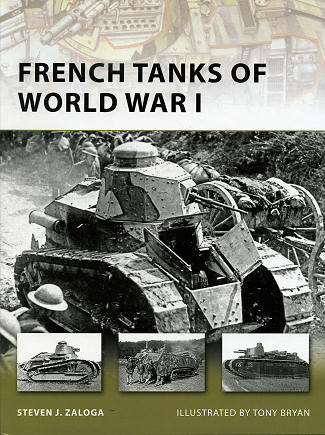 One
of my favorite series in the Osprey catalogue is the New Vanguard line of books.
They basically deal with equipment and do a superb job of covering whatever the
subject might be. This particular one is on French Tanks of WWI. Though the
British may get all the press about tanks at Cambrai, it is the French who
settled on the basic design of the tank that has not changed in nearly 100
years.
One
of my favorite series in the Osprey catalogue is the New Vanguard line of books.
They basically deal with equipment and do a superb job of covering whatever the
subject might be. This particular one is on French Tanks of WWI. Though the
British may get all the press about tanks at Cambrai, it is the French who
settled on the basic design of the tank that has not changed in nearly 100
years.
The first operational tank designed by the French was pretty
much of what I'd call the 'war wagon' variety that was large, had a big cannon
and several machine guns, and had a rather hefty number of people crammed
inside. It was designed by Schneider and was somewhat successful. This was
followed by the larger and even less useful St.Chamond.
It was rather obvious that heavy tanks had a great deal of
development before they'd be truly useful. At least so it seemed with French
tanks.
What really got the ball rolling was the Renault FT 17. This
looked like a real tank and was very much a light tank, armed with a single
machine gun or a small 37mm cannon. It had a centrally mounted rotating turret
that was either cast or made of plate armor. It had a small crew and while, like
all tanks of the time, it had a rather unreliable engine and drive, it could be
built in rather large numbers and was nimble enough to get over the broken
ground of no-man's land. It was also able to withstand enemy machine guns and
was a huge morale boost to the highly dispirited French troops.
So successful was the FT 17 design that it was still to be
found in 1940, fighting the German invasion. It was used by a huge number of
nations and was the main tank used by the US military until the 1930s.
Author Steven Zaloga covers the design, development and
deployment of the various French designs and how these vehicles affected the
various battles in which they were used. There is also a huge political
background regarding these tanks as it wasn't a shoe-in for their use. Such were
the machinations in the halls of the bureaucrats that it is truly surprising
that the French military could operate at all.
All of this is fully covered and superbly illustrated by some
fine period photographs as well as the excellent art work of Illustrator Tony
Bryan. Together, this puts forth an excellent look at early tanks and tank
warfare. It makes for a book that is an absolute must for any armor enthusiast.
When you see it, buy it.
December 2010
For more on the complete line of Osprey books,
visit www.ospreypublishing.com. In the US, it is
Osprey Direct at 44-02 23rd St, Suite 219, Long Island City, NY 11101., where you can
get a catalogue of available books.
If you would like your product reviewed fairly and quickly, please contact
me or see other details in the Note to
Contributors.
 One
of my favorite series in the Osprey catalogue is the New Vanguard line of books.
They basically deal with equipment and do a superb job of covering whatever the
subject might be. This particular one is on French Tanks of WWI. Though the
British may get all the press about tanks at Cambrai, it is the French who
settled on the basic design of the tank that has not changed in nearly 100
years.
One
of my favorite series in the Osprey catalogue is the New Vanguard line of books.
They basically deal with equipment and do a superb job of covering whatever the
subject might be. This particular one is on French Tanks of WWI. Though the
British may get all the press about tanks at Cambrai, it is the French who
settled on the basic design of the tank that has not changed in nearly 100
years.